Who We Are
the cattery
We are a small Birman cattery in the Bodensee Region in Germany. I breed with love and care and the cats are considered family members. We live in an apartment with a cat safe balcony. The cats have free access to the home, with cat trees and shelves throughout, and they even have their own playroom. While they enjoy relaxing there, I love when they choose to sleep in my bedroom. They also enjoy sleeping outside, and when the weather is nice, the door to the balcony is open day and night.
Birmans are incredibly social cats who love being part of the family—both furry and human. I feel the same way about them, which is why they even come on holidays with me! They’re surprisingly adaptable, handling long car rides with patience and settling into hotel rooms with curiosity. When I take out the transport box, Mia and Theodor compete to see who can occupy it first. My cats are also accustomed to leashes and harnesses, and we enjoy walks on holidays. Due to the risk of infections and parasites, I don’t take the cats outside when we have kittens.
Of course, living with breeding cats comes with challenges. I don’t believe in isolating a male just to prevent marking—it wouldn’t be fair to him. But at the same time, I don’t want a smelly home (or a hotel disaster!). So, when my stud is in his active phase, he wears cat pants. That way, he stays with us as part of the family.
And doesn’t he look stylish in his little shorts? 😀
The family
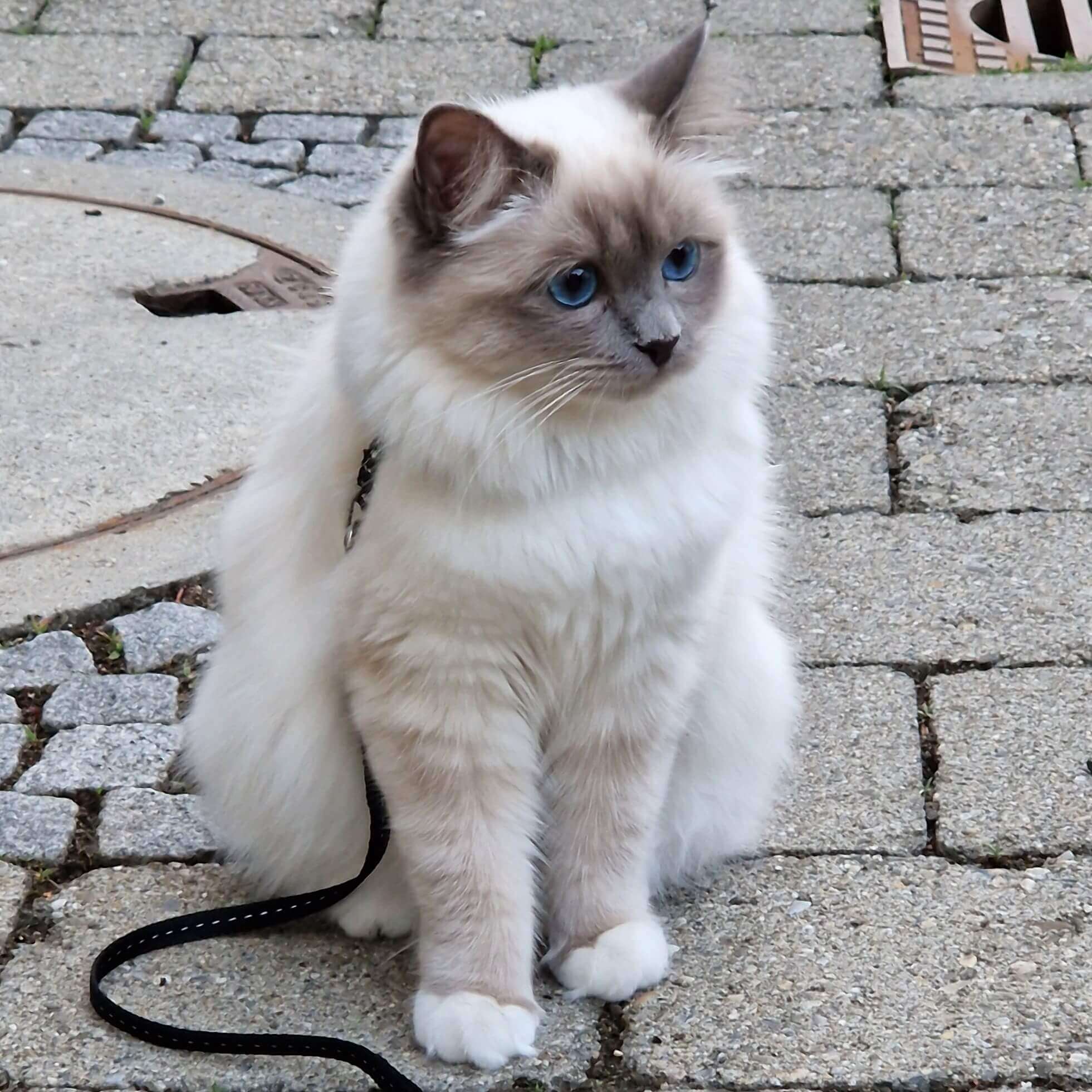
Missie
Blue point female
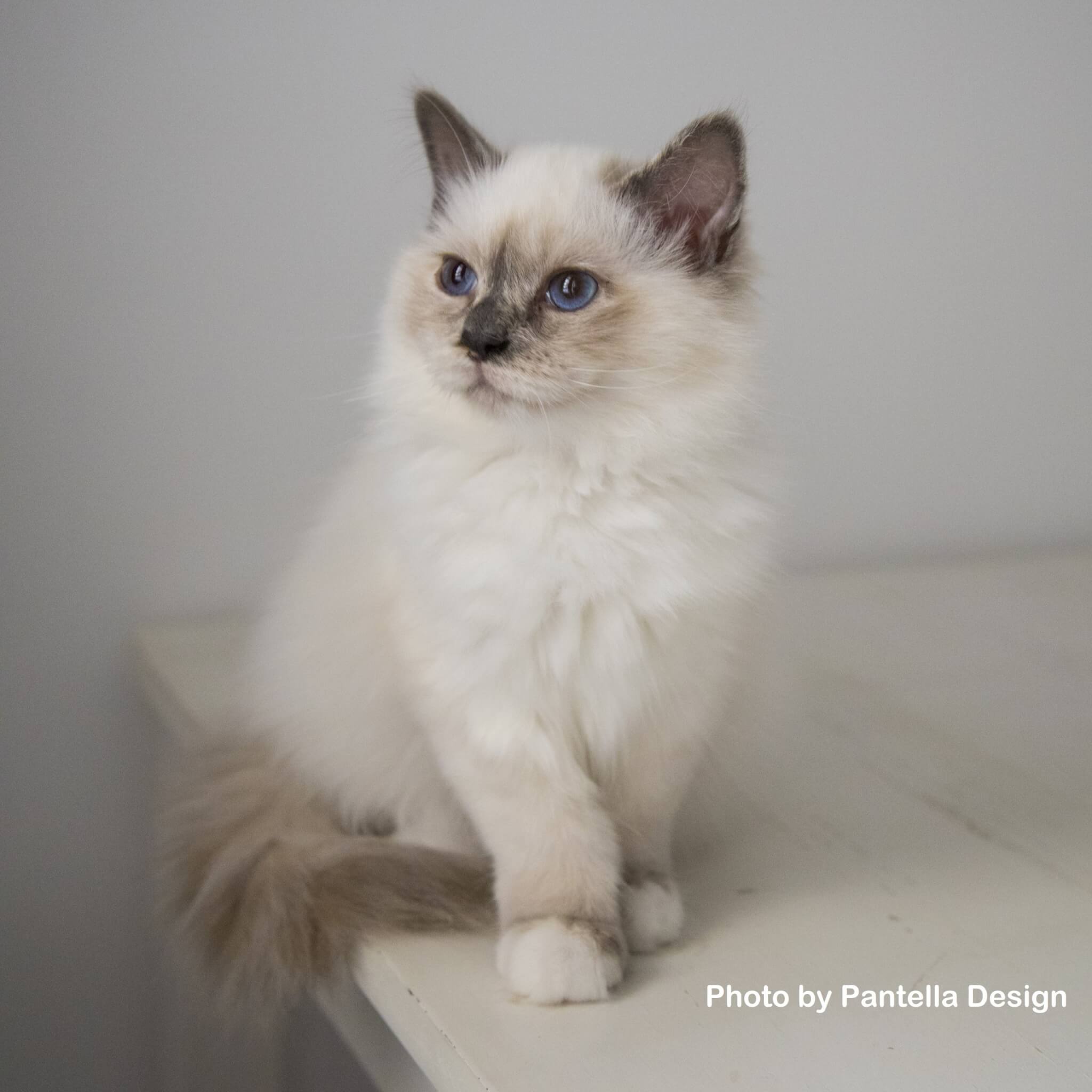
Lilou
Blue tortie point female
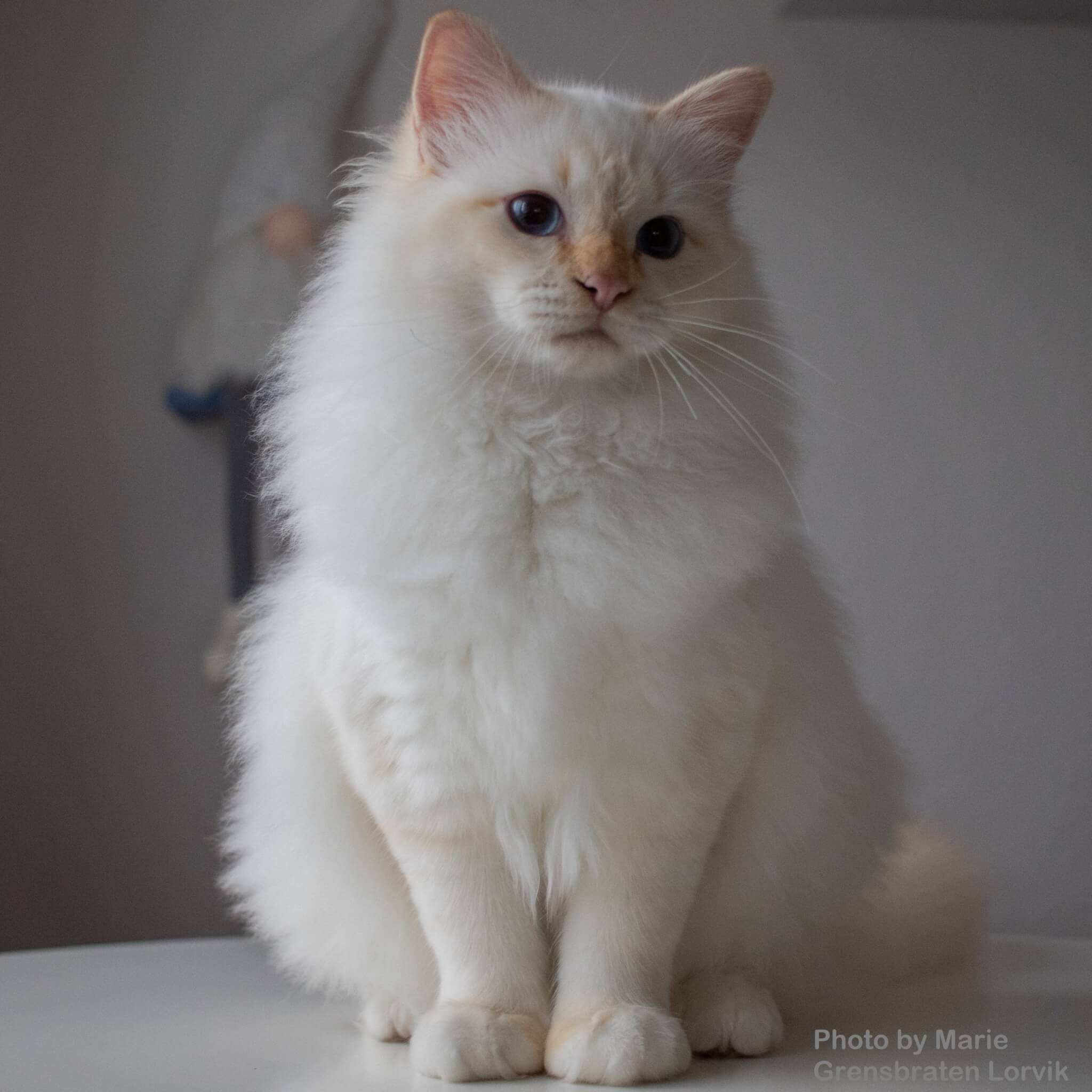
Theodor
Red point male
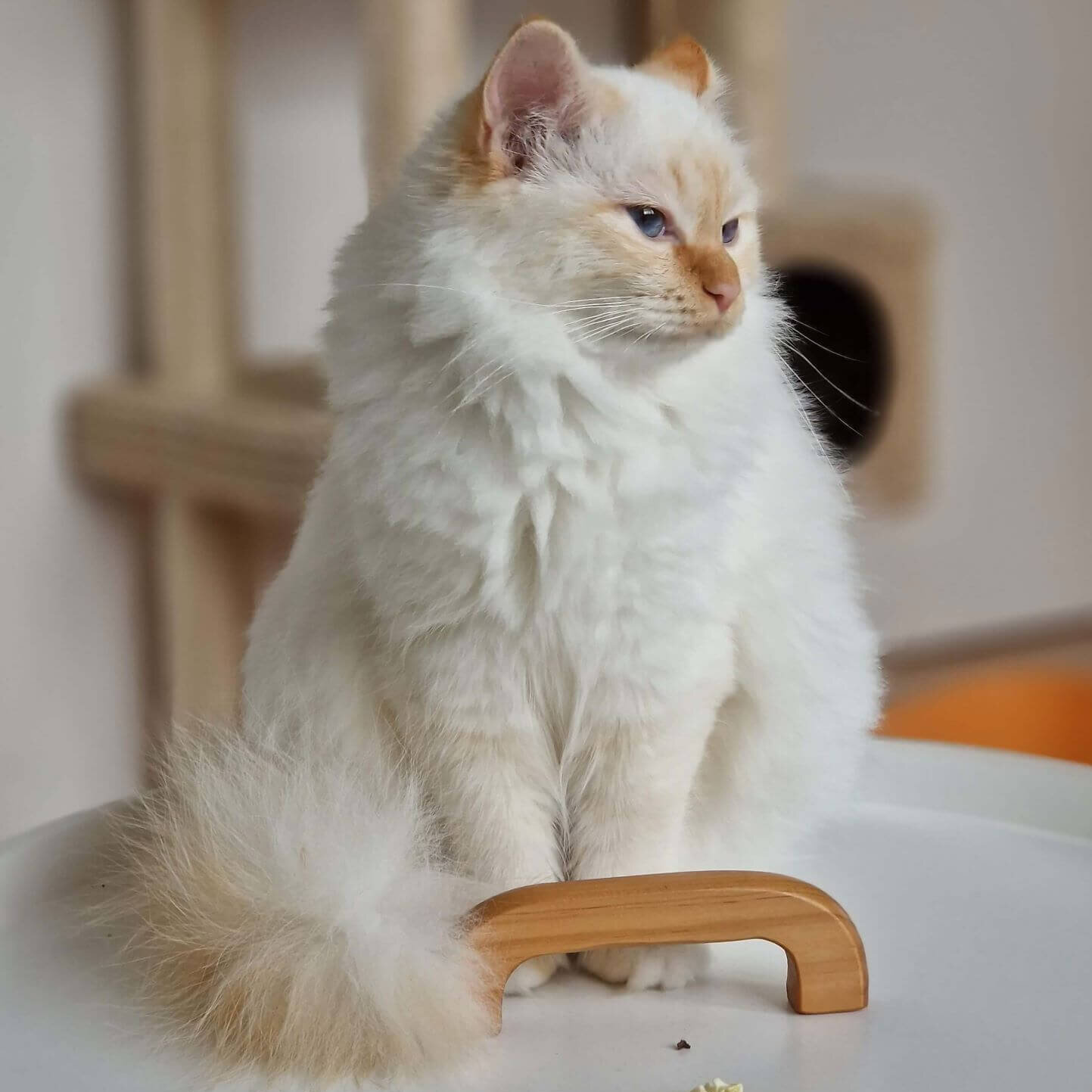
Mia
Red point retiree
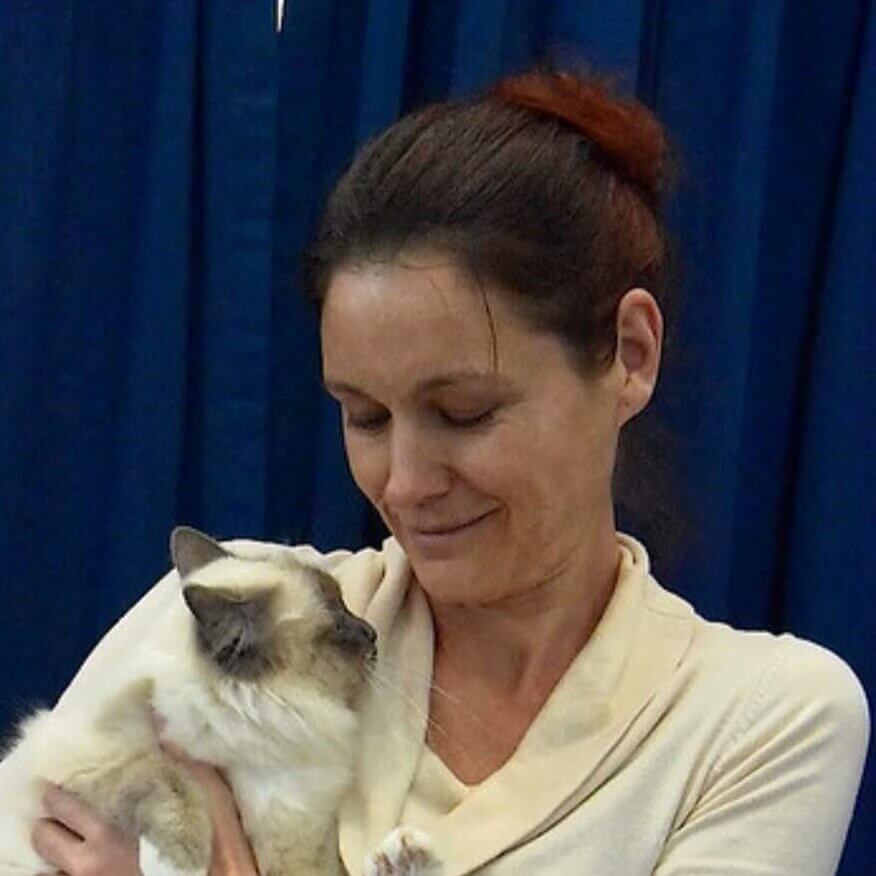
Orsolya
Take-carer
mirmurillum
Since early childhood I was dreaming about becoming a cat breeder one day. Once I saw a photo of a kitten with mesmerizing blue eyes and grey face. It was love at first sight. I researched and found out the kitten was a blue point Sacred Birman. There was no doubt this was the breed I wanted to focus on.
I registered as a breeder in 2022 with DEKZV (1. Deutscher Edelkatzenzüchter Verband e.V.), the local member of FIFe. The name, Mirmurillum was put on record in 2023.
When I was looking for a breeder name, I was aiming for a unique name that has a meaningful definition to me and sounds good as well. Murmurillum is a latin word, it means purr (feline purr).
A purring cat – for me – is the symbol of content and happiness. The relaxing murmuring sound and the knowing that my cat is content, makes me happy. Purring releases endorphins in cats, and it can do the same thing in humans, too.
My breeding program
My mission is to preserve and enhance the magical Birman breed by breeding healthy, affectionate, and potentially show-quality kittens that align with the breed standard in both appearance and temperament. As an ethical breeder, I go beyond the basic requirements to ensure the health and well-being of my cats. I follow responsible breeding practices to ensure that being part of a breeding program does not compromise their quality of life while allowing them to contribute to the breed’s improvement with each generation.
Birmans come in a variety of colors, and while I love them all, I have a special love for the red/cream line and blue color. These are the colors I prioritize in my breeding program.
Focusing on health
Health is very important to me. I avoid overbreeding, ensuring my females have a maximum of one litter per year to allow proper recovery.
I feed my cats high-quality, grain-free food and avoid sugars and dairy products. I conduct regular stool tests to detect parasites but also routinely deworm kittens. While I try to minimize unnecessary deworming, as it can be hard on the body, lab tests don’t always catch all parasites. In my view, a deworming treatment is less harmful than undetected parasites that could severely impact a kitten’s health.
All my cats are tested for Feline Immunodeficiency Virus (FIV) and Feline Leukemia Virus (FeLV), and I repeat the HCM and PKD ultrasound examinations yearly.
Hypertrophic Cardiomyopathy (HCM) is an inherited heart disease that typically shows its first signs between 3 and 7 years of age. Unfortunately, no reliable genetic test exists for Birmans (tests for other breeds are available but not fully accurate for Birmans). The only way to minimize the risk in my breeding lines is through regular heart screenings.
Polycystic Kidney Disease (PKD) is a genetic disorder that causes fluid-filled cysts to form in the kidneys. Unlike HCM, PKD is usually present from birth, though symptoms may not appear until later in life. It can be reliably diagnosed via ultrasound screening.
Socializing the kittens
A good temperament is partly inherited but also shaped by socialization. The kittens stay with us until they are 14 weeks old, allowing them to learn essential communication skills from their mother and the other cats in the family. I allow the mothers to introduce them to the rest of the cats early on, letting them play together with cousins regardless of age differences.
To help them adapt to various experiences, I invite friends with young children so the kittens become comfortable with people of all ages. I also do playful vacuum cleaner training to ensure they are not afraid of household noises. They have plenty of climbing and hiding spots, learn how to climb down from poles (like trees), and enjoy lots of hunting games with me.
I handle them often so they enjoy being held and try to teach them early on not to climb on people.
Following the breed standard
In my breeding program, I strive to follow the Birman breed standard to preserve the unique traits that make this breed so special. A well-bred, show-quality Birman should have a medium-sized body, a silky coat with little undercoat, distinct color points, a well-defined profile with a Roman nose, correctly set ears of the right size and with rounded tip, deep blue eyes with slightly oval shape, and perfect white gloves on all four paws.
While achieving perfection in every trait is nearly impossible, breeders must work toward this ideal. My priority is a well-balanced overall appearance with a good, short profile and well-set small ears. I also aim to improve fur quality and hope to enhance the depth of blue in my lines’ eyes, though this is not my main focus for now. To ensure I am on the right path, I present my cats at shows, where certified judges provide valuable feedback. A cat rated Excellent 1 (EX1) in its category (breed, color, and sex) earns a Certificate of Aptitude for the Championship (CAC). By collecting three CAC certificates from different judges, a cat achieves the Champion title. I am proud that all my cats have earned this distinction.
Official FIFe breed standard in multilingual pdf format here.
Commitment to learning
Breeding cats is a big responsibility. Besides the fact that breeders are responsible for preserving the characteristics of the breed and making improvements, most importantly, the health of the next generation depends on them. The kittens’ health is influenced by their bloodline, inherited diseases, and, of course, the nutrition and care they and their mothers receive.
It is essential that breeders understand what is best for their cats—what diseases exist and how to prevent them, what complications can arise during birth and how to handle them, and much more. Producing kittens without the necessary knowledge goes against my ethics.
When I decided to start breeding, I knew I wanted to gain extensive knowledge before getting my first breeding cat. This is how I found PawPeds.
PawPeds is an organization dedicated to educating cat breeders and maintaining an international pedigree database. They run health programs in collaboration with cardiologists and other specialists to reduce genetic diseases in cats, and their website includes a tool to calculate the inbreeding coefficient for planned matings.
I believe in lifelong learning, and there is always more to discover about cat breeding—genetics, cat psychology, nutrition…
The more I learn, the more I realize how much there is still to learn. 🙂

PawPeds G1 Course - 2021
In 2021, I successfully completed the General course step 1 (G1) with PawPeds Academy. The course provided basic knowledge about cat ownership, health, nutrition and safety.

PawPeds G2 Course - 2022
Step 2 of the general course, G2, provides knowledge about pregnancy, kittens' development, basic genetics and breeding plans. I successfully completed the course in 2022.

PawPeds Course Leader
I had the honor of being invited to volunteer as a tutor for the PawPeds courses, contributing to the education of fellow breeders. Since 2023, I have served as a course leader for G1 courses and will continue supporting the well-being of breeding cats through my work.
Responsibility for kittens
I do everything I can to give my kittens the best foundation for a happy, long, and healthy life. My queens have at most one litter per year, ensuring they have enough time to fully recover before the next pregnancy and can give birth to strong, healthy babies. Since the parents are tested negative for FIV/FeLV, the kittens are also free from these diseases.
The kittens spend the first three months of their lives with me, growing, playing, and developing under my care. I witness their birth, watch them take their first steps, and interact with them daily. I love them deeply, and it’s never easy to say goodbye. If I could, I would keep them all, but that would make it impossible to continue my breeding program and work towards improving the breed. I let them go, but I carefully select the right families for them.
My priority is to find homes where they will be safe, loved, and well cared for, with access to proper healthcare and high-quality food.
If you’re interested in learning more about my breeding program, feel free to reach out!
Contact Info
Let’s get in touch!
Send an email or contact me on Whatsapp.
Orsolya Horvath
+49 1522 3733920
Konstanz, 78467 GERMANY

